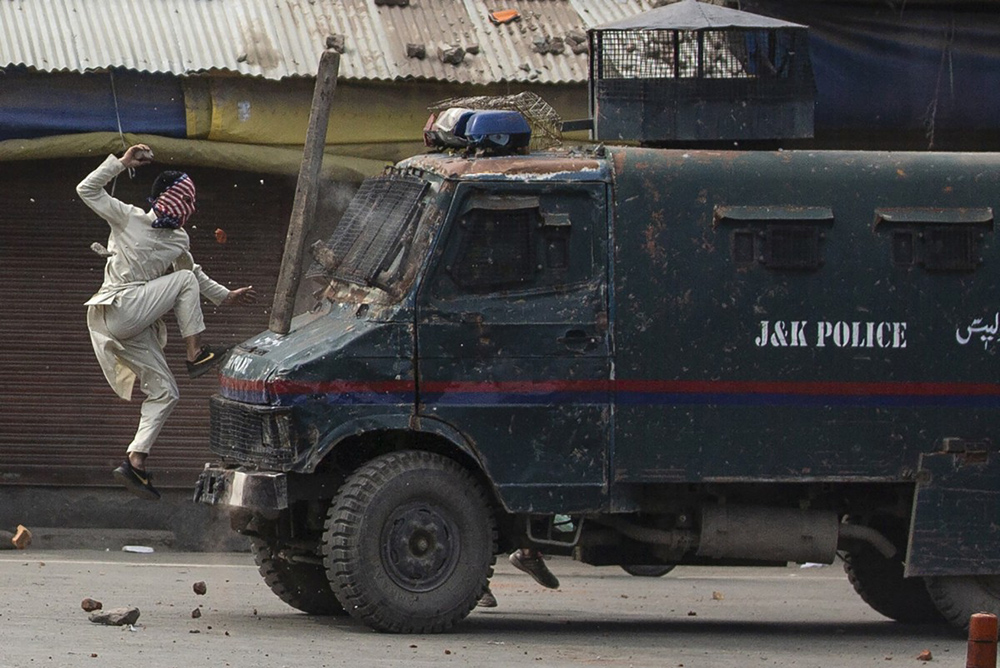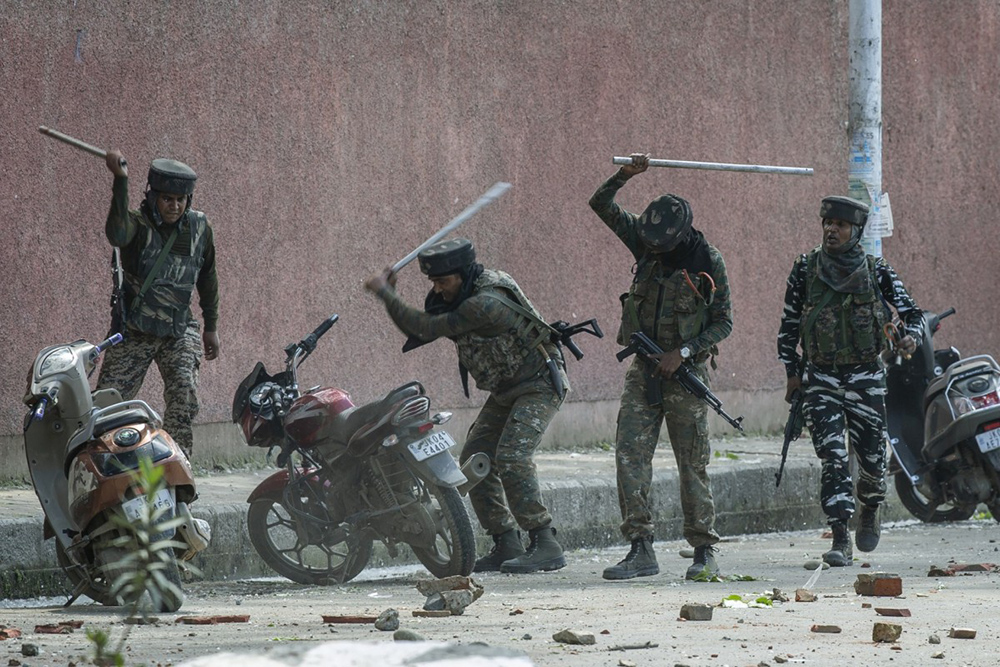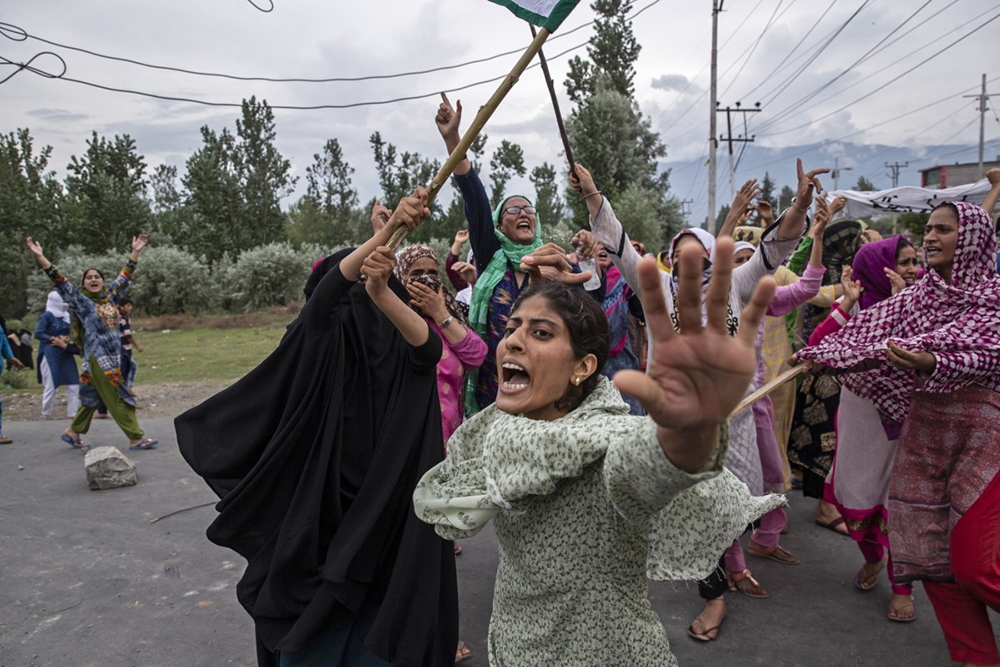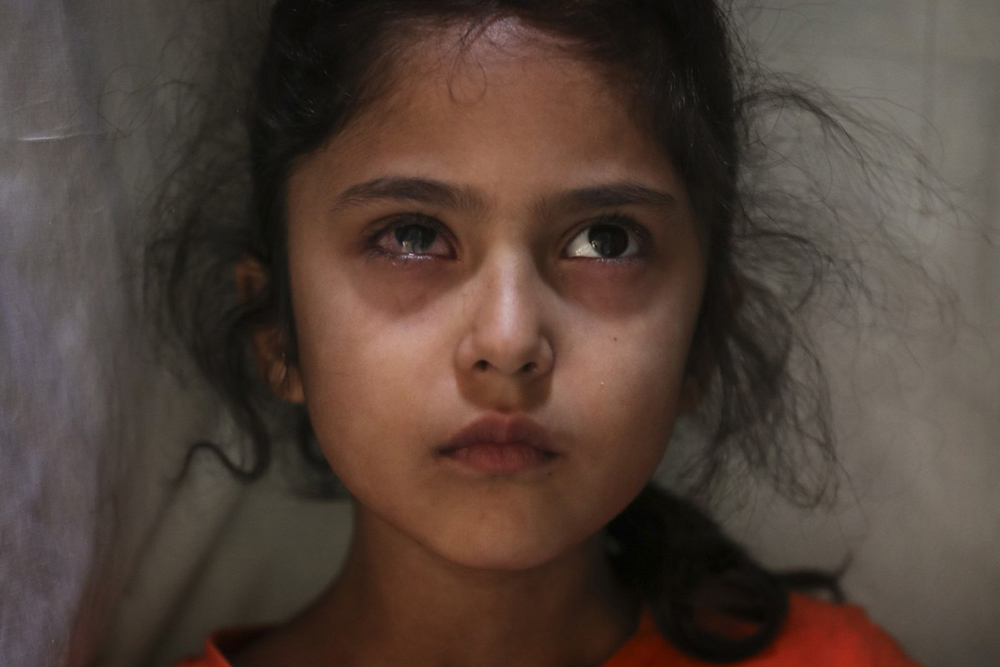Written by: Senator Mushahid Hussain Sayed
Posted on: August 05, 2020 |  | 中文
| 中文
Masked Kashmiris shout slogans during a protest after Friday prayers on the outskirts of Srinagar, Indian controlled Kashmir (Photo credits to Channi Anand, Mukhtar Khan and Dar Yasin of Associated Press)
Never before in the history of Occupied Kashmir has the struggle of the Kashmiri people received such widespread global resonance as in the last one year. 365 days after the longest lockdown in modern history, the people of Indian Occupied Kashmir (IOK) remain defiant and unbowed in their determination to resist the repression unleashed by a million-strong occupation force. This valour and spirit of sacrifice of the children, women and men have few parallels in the annals of resistance movements. Ever since India’s Modi regime announced on August 5, 2019, their decision to annex the state of IOK, it has unleashed consequences which Modi’s India is finding difficult to control, for, under international law, like Palestine, it continues to be a disputed territory on the United Nations agenda. From US Presidential candidate Joe Biden to European Parliamentarians, UN Secretary-General Antonio Guterres and the Head of the Human Rights Council, Michelle Bachelet, all voice their concern and condemnation on Modi’s move which has boomeranged badly. The Pulitzer Prize for Kashmiri photographers graphically captured on camera the repression and resistance in Occupied Kashmir, and protests have taken place in Dhaka and in Houston by Kashmiri and Khalistani activists against the annexation of Kashmir.

A masked Kashmiri protester jumps on the bonnet of an armored vehicle of Indian police as he throws stones at it during a protest in Srinagar, Indian controlled Kashmir (Photo credits to Channi Anand, Mukhtar Khan and Dar Yasin of Associated Press)
This August 5, 2020, on the Day of Solidarity with the Kashmiri people, it is worth examining the ramifications of what is now increasingly being perceived as a monumental blunder by the Indian regime, and whose impact now goes much beyond the occupied territory to include India as well as the broader regions, including Pakistan and China. Three such effects are particularly noteworthy.
First, India’s centrifugal forces have been roused in a manner that won’t be easy to control, reflected in the protracted struggle of 17 different insurgencies for greater autonomy, and even independence, that affects that vast subcontinent. This has happened in the case of Nagaland and Manipur, where ongoing negotiations with New Delhi have broken down after the Indian annexation of Occupied Kashmir, the rationale being if Kashmiri identity enshrined in some form of ‘limited autonomy’ granted by Article 370 of the Indian Constitution can be quashed by executive diktat, then the same can happen to the regions in India’s Northeast, which are restive and seek a new role with greater autonomy within the Indian Union. And in the case of the Punjab, which saw massacres and state-sponsored military action in 1984 on the sacred Sikh Golden Temple in Amritsar, followed by mass attacks and burning alive of some 5000 Sikhs in the wake of Prime Minister Indira Gandhi’s assassination in October 1984, there is even a yearning for independence, reflected in the Khalistan Referendum of 2020 that Sikh separatists have proposed.
Second, after the attempt to change the demography of Occupied Kashmir by reducing its Muslim majority into a minority, the Modi regime has even gone to the extent of the promulgation of the Citizen Amendment Act (CAA) and the National Register of Citizens (NRC), which has disenfranchised 2 million Muslims in Assam, and laid the foundation of a divisive and discriminatory ‘Republic of Hindustan’. The mass protests evoked by these actions, in the pre-Coronavirus period, the most serious and substantial attempt to transform the Indian state’s secular and pluralist ethos, has had a national backlash spread across over 100 universities and college campuses. And, ironically, the popular anthem of resistance was Pakistani poet Faiz Ahmed Faiz’s iconic and fiery poem (Hum dekhein gai), an Urdu version of the “We Shall Overcome” anthem of the American Civil Rights Movement. The demographic aggression by India against the Kashmiri people is on a wide, systematic scale, changing laws like the 1970 Building Operations Act, injecting outsiders into the occupied territory like 100,000 Prachariks (ideological storm troopers of RSS), distributing land to ex-soldiers and former bureaucrats, plus establishing separate colonies on prime land for Hindu settlers from outside Jammu and Kashmir.

Indian paramilitary soldiers break motorbikes parked outside a college as they clash with students protesting against the alleged rape of a 3-year-old girl in Srinagar, Indian controlled Kashmir (Photo credits to Channi Anand, Mukhtar Khan and Dar Yasin of Associated Press)
Third, there are regional ramifications of the Indian annexation of Occupied Kashmir, which affect Pakistan and China directly as neighbours who have had a conflicted relationship with India, and a new border dispute has been created. Both Pakistan and China have rejected the Indian annexation as ‘unacceptable’! So this action poses a threat to peace, security and stability in the region. One consequence of August 5 is that China is now a direct party to the Kashmir dispute, in this case, a force multiplier, a voice for justice for the Kashmiris at global fora like the United Nations. Compounding the problems for India is the Ladakh clash with China, which resulted in a big humiliation for the Indian Army, plus aborted Indian bullying against smaller neighbours like Bangladesh, Naples and Sri Lanka.
There are broader implications of the Indian moves - annexation of Occupied Kashmir, CAA and NRC - which cumulatively are leading to the creation of what the eminent Indian writer, Arundhati Roy has termed as the ‘architecture of fascism in India’, with the RSS, an Indian offshoot of Hindu extremism inspired by European fascism of the 1930s, whose ideologues were inspired by the exclusive ‘racial purity’ and ethnic cleansing policies of Hitler and Mussolini. Modi is following a deliberate policy of economic strangulation of local agriculture and indigenous industry in order to kill all resistance by the Kashmiris. This has been best summed up by prominent English newsmagazine ‘The Economist’, which carried a cover story ‘Intolerant INDIA’ with the apt subtitle ‘How Modi is endangering the world’s largest democracy’.

Women shout slogans as Indian policemen fire teargas and live ammunition in the air to stop a protest march in Srinagar, Indian controlled Kashmir (Photo credits to Channi Anand, Mukhtar Khan and Dar Yasin of Associated Press)
At the heart of it all is the situation of the beleaguered people of Occupied Kashmir, which has the world’s oldest Armistice manned by UN peacekeepers plus 24 resolutions committing the United Nations to hold a plebiscite to determine the future of the 12 million Kashmiris.
One year after the annexation of Occupied Kashmir, it is clear that Modi’s move was a monumental miscalculation, and he and his regime are clueless as to how to continue beyond the clampdown, control and curfews that have become the norm of their brutal occupation. The international community, particularly the media and parliaments of the United States, UK and the European Union, have risen to the occasion to voice their critique of unacceptably worsening human rights situations, where genocidal tendencies and ethnic cleansing are among the worst feared scenarios.

Six-year-old Muneefa Nazir, a Kashmiri girl whose right eye was hit by a marble ball shot allegedly by Indian Paramilitary soldiers on Aug. 12, stands outside her home in Srinagar, Indian controlled Kashmir (Photo credits to Channi Anand, Mukhtar Khan and Dar Yasin of Associated Press)
Ironically, the situation in Indian Occupied Kashmir has coincided with the 75th Anniversary of the infamous Nazi concentration camp at Auschwitz, where survivors gathered with the rallying cry “Never Again”, as well as the 25th Anniversary of the ethnic cleansing of Muslims at Srebrenica in Bosnia-Herzegovina. However, in the 21st Century, in an age of information, a newer and equally brutal version of Auschwitz and Srebrenica is appearing under the auspices of a regime whose clearly stated ideology and practice is similar to that of the architects of Auschwitz and Srebrenica. ‘Never Again’ for the suffering Kashmiri people, therefore, sounds like a hollow slogan as they remain consigned to their fate in the world’s biggest concentration camp, as if they are ‘children of a lesser god’.
Whatever the professions of the Modi regime, one year after August 5, 2019, the failure to subdue the Kashmiri people stands as a stark reminder that the Indian State, which has positioned a million men under arms in the Valley cannot subdue or suppress the indomitable spirit of the Kashmiris and their passion for ‘Azadi’.
You may also like: